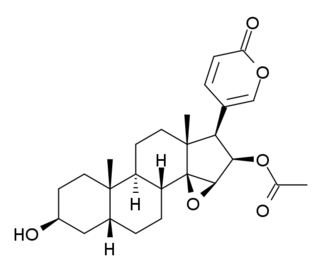
Hepatocellular carcinoma (HCC) is the most common type of primary liver cancer in adults and is currently the most common cause of death in people with cirrhosis. HCC is the third leading cause of cancer-related deaths worldwide.

5-MeO-DMT (5-methoxy-N,N-dimethyltryptamine) or O-methyl-bufotenin is a psychedelic of the tryptamine class. It is found in a wide variety of plant species, and also is secreted by the glands of at least one toad species, the Colorado River toad. Like its close relatives DMT and bufotenin (5-HO-DMT), it has been used as an entheogen in South America. Slang terms include Five-methoxy, the power, bufo, and toad venom.

Everolimus, sold under the brand name Afinitor among others, is a medication used as an immunosuppressant to prevent rejection of organ transplants and as a targeted therapy in the treatment of renal cell cancer and other tumours.

Bufotoxins are a family of toxic steroid lactones or substituted tryptamines of which some are toxic. They occur in the parotoid glands, skin, and poison of many toads and other amphibians, and in some plants and mushrooms. The exact composition varies greatly with the specific source of the toxin. It can contain 5-MeO-DMT, bufagins, bufalin, bufotalin, bufotenin, bufothionine, dehydrobufotenine, epinephrine, norepinephrine, and serotonin. Some authors have also used the term bufotoxin to describe the conjugate of a bufagin with suberylarginine.
Bufagin is a toxic steroid C24H34O5 obtained from toad's milk, the poisonous secretion of a skin gland on the back of the neck of a large toad (Rhinella marina, synonym Bufo marinus, the cane toad). The toad produces this secretion when it is injured, scared or provoked. Bufagin resembles chemical substances from digitalis in physiological activity and chemical structure.

Bufotalin is a cardiotoxic bufanolide steroid, cardiac glycoside analogue, secreted by a number of toad species. Bufotalin can be extracted from the skin parotoid glands of several types of toad.

The Colorado River toad, also known as the Sonoran Desert toad, is a toad species found in northwestern Mexico and the southwestern United States. It is well known for its ability to exude toxins from glands within its skin that have psychoactive properties.

Sorafenib, sold under the brand name Nexavar, is a kinase inhibitor drug approved for the treatment of primary kidney cancer, advanced primary liver cancer, FLT3-ITD positive AML and radioactive iodine resistant advanced thyroid carcinoma.

T-box transcription factor T, also known as Brachyury protein, is encoded for in humans by the TBXT gene. Brachyury functions as a transcription factor within the T-box family of genes. Brachyury homologs have been found in all bilaterian animals that have been screened, as well as the freshwater cnidarian Hydra.

RhoC is a small signaling G protein, and is a member of the Rac subfamily of the family Rho family of GTPases. It is encoded by the gene RHOC.

Forkhead box protein M1 is a protein that in humans is encoded by the FOXM1 gene. The protein encoded by this gene is a member of the FOX family of transcription factors. Its potential as a target for future cancer treatments led to it being designated the 2010 Molecule of the Year.

Fibroblast growth factor 19 is a protein that in humans is encoded by the FGF19 gene. It functions as a hormone, regulating bile acid synthesis, with effects on glucose and lipid metabolism. Reduced synthesis, and blood levels, may be a factor in chronic bile acid diarrhea and in certain metabolic disorders.

Sodium-coupled monocarboxylate transporter 1 (i.e., SMCT1) and sodium-coupled monocarboxylate transporter 2 (i.e., SMCT2) are plasma membrane transport proteins in the solute carrier family. They transport sodium cations in association with the anionic forms (see conjugated base) of certain short-chain fatty acids (i.e., SC-FAs) through the plasma membrane from the outside to the inside of cells. For example, propionic acid (i.e., CH
3CH
2CO
2H) in its anionic "propionate" form (i.e., CH
3CH
2CO−
2) along with sodium cations (i.e., Na+) are co-transported from the extracellular fluid into a SMCT1-epxressing cell's cytoplasm. Monocarboxylate transporters (MCTs) are also transport proteins in the solute carrier family. They co-transport the anionic forms of various compounds into cells in association with proton cations (i.e. H+). Four of the 14 MCTs, i.e. SLC16A1 (i.e., MCT1), SLC16A7 (i.e., MCT22), SLC16A8 (i.e., MCT3), and SLC16A3 (i.e., MCT4), transport some of the same SC-FAs anions that the SMCTs transport into cells. SC-FAs do diffuse into cells independently of transport proteins but at the levels normally occurring in tissues far greater amounts of the SC-FAs are brought into cells that express a SC-FA transporter.

StAR-related lipid transfer domain protein 13 (STARD13) also known as deleted in liver cancer 2 protein (DLC-2) is a protein that in humans is encoded by the STARD13 gene and a member of the DLC family of proteins.

Arenobufagin is a cardiotoxic bufanolide steroid secreted by the Argentine toad Bufo arenarum. It has effects similar to digitalis, blocking the Na+/K+ pump in heart tissue.

Cinobufagin is a cardiotoxic bufanolide steroid secreted by the Asiatic toad Bufo gargarizans. It has similar effects to digitalis and is used in traditional Chinese medicine.

Tetrandrine, a bis-benzylisoquinoline alkaloid, is a calcium channel blocker. It is isolated from the plant Stephania tetrandra, and other Chinese and Japanese herbs.

Bufothionine is a sulfur-containing compound which is present in the bufotoxins secreted by the parotoid gland of certain toads of the genera Bufo and Chaunus. This specific compound can be found in the skin of certain species of toad such as the Asiatic Toad, Chaunus arunco, Chaunus crucifer, Chaunus spinulosus, and Chaunus arenarum.
Lewis lung carcinoma is a tumor that spontaneously developed as an epidermoid carcinoma in the lung of a C57BL mouse. It was discovered in 1951 by Dr. Margaret Lewis of the Wistar Institute and became one of the first transplantable tumors.
HuaChanSu is a traditional Chinese medicine extracted from the skin of toads from the genus Bufo that is believed by some to slow the spread of cancerous cells. The parotoid gland of toads of the Bufo genus secrete a venom, which is dried and dissolved in water. This solution, HuaChanSu, is injected into a cancerous area and targets specific cancer cells. HuaChanSu is undergoing further trials, and its effect is not completely understood.


















